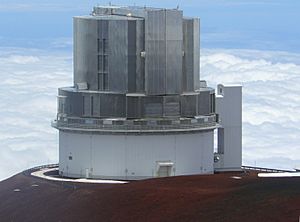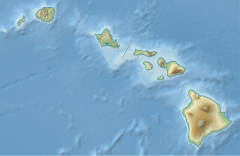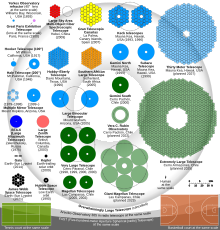Subaru Telescope facts for kids

The Subaru Telescope
|
|
| Part of | Mauna Kea Observatories National Astronomical Observatory of Japan |
|---|---|
| Location(s) | Mauna Kea, Mauna Kea, Hawaii, US |
| Coordinates | 19°49′32″N 155°28′34″W / 19.8256°N 155.4761°W |
| Organization | National Astronomical Observatory of Japan |
| Observatory code | T09 |
| Altitude | 4,139 m (13,579 ft) |
| Wavelength | Optical/Infrared |
| Built | Completed 1998 |
| Telescope style | optical telescope reflecting telescope Ritchey–Chrétien telescope |
| Diameter | 8.3 m (8.2 m usable) |
| Secondary diameter | 1330/1400/1265 mm |
| Angular resolution | 0.23″ |
| Collecting area | 53 m2 (570 sq ft) |
| Focal length | f/1.83 (15.000 m) |
| Mounting | Altitude/Azimuth |
| Enclosure | cylindrical dome |
| Website | www |
Subaru Telescope (すばる望遠鏡, Subaru Bōenkyō) is the 8.2-metre (320 in) telescope of the National Astronomical Observatory of Japan, located at the Mauna Kea Observatory on Hawaii. It is named after the open star cluster known in English as the Pleiades. It had the largest monolithic primary mirror in the world from its commissioning until 2005.
Overview
The Subaru Telescope is a Ritchey-Chretien reflecting telescope. Instruments can be mounted at a Cassegrain focus below the primary mirror; at either of two Nasmyth focal points in enclosures on the sides of the telescope mount, to which light can be directed with a tertiary mirror; or at the prime focus in lieu of a secondary mirror, an arrangement rare on large telescopes, to provide a wide field of view suited to deep wide-field surveys.
In 1984, the University of Tokyo formed an engineering working group to develop and study the concept of a 7.5-metre (300 in) telescope. In 1985, the astronomy committee of Japan's science council gave top priority to the development of a "Japan National Large Telescope" (JNLT), and in 1986, the University of Tokyo signed an agreement with the University of Hawaii to build the telescope in Hawaii. In 1988, the National Astronomical Observatory of Japan was formed through a reorganization of the University's Tokyo Astronomical Observatory, to oversee the JNLT and other large national astronomy projects.
Construction of the Subaru telescope began in April 1991, and later that year, a public contest gave the telescope its official name, "Subaru Telescope". Construction was completed in 1998, and the first scientific images were taken in January 1999. In September 1999, Princess Sayako of Japan dedicated the telescope.
A number of state-of-the-art technologies were worked into the telescope design. For example, 261 computer-controlled actuators press the main mirror from underneath, which corrects for primary mirror distortion caused by changes in the telescope orientation. The telescope enclosure building is also shaped to improve the quality of astronomical images by minimizing the effects caused by atmospheric turbulence.
Subaru is one of the few state-of-the-art telescopes to have been used with the naked eye. For the dedication, an eyepiece was constructed so that Princess Sayako could look through it directly. It was enjoyed by the staff for a few nights until it was replaced with the much more sensitive working instruments.
Subaru is the primary tool in the search for Planet Nine. Its large field of view, 75 times that of the Keck telescopes, and strong light-gathering power are suited for deep wide-field sky surveys. The search, split between a research group led by Konstantin Batygin and Michael Brown and another led by Scott Sheppard and Chad Trujillo, is expected to take up to five years.
Instruments
Several cameras and spectrographs can be mounted at Subaru Telescope's four focal points for observations in visible and infrared wavelengths.
-
The Subaru alongside the twin W. M. Keck Observatory telescopes and the Infrared Telescope Facility
-
Dark matter map from 2018 by the Hyper Suprime-Cam survey
See also
 In Spanish: Telescopio Subaru para niños
In Spanish: Telescopio Subaru para niños
- List of largest optical reflecting telescopes
- Yūko Kakazu





